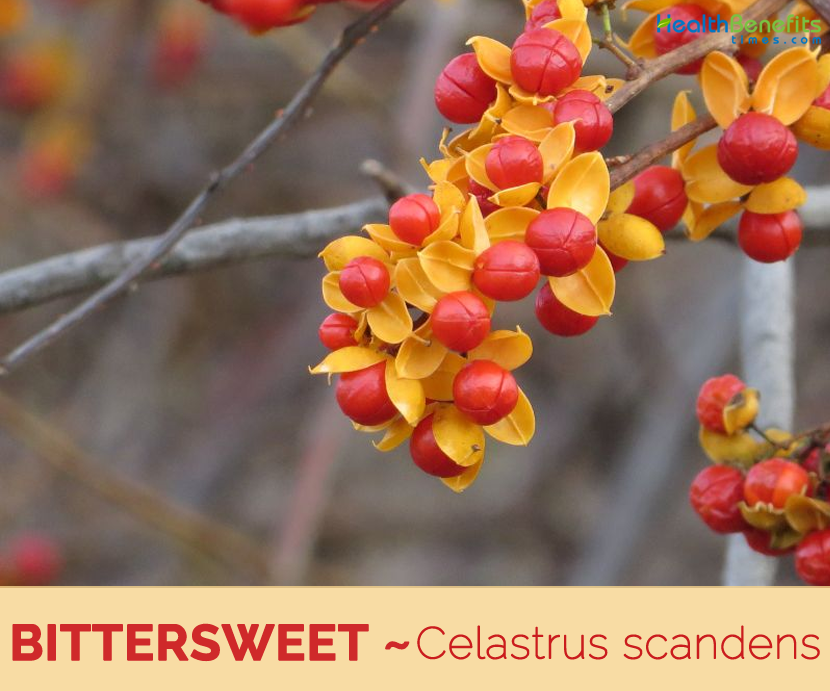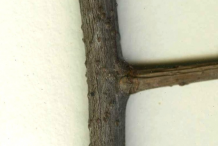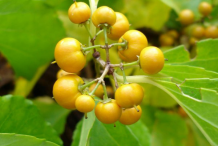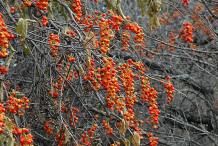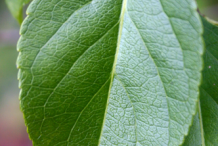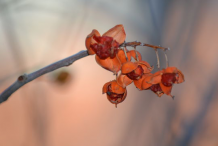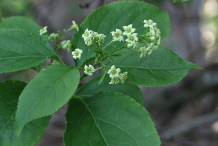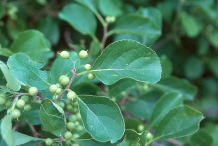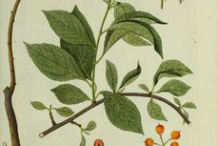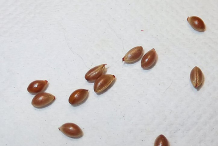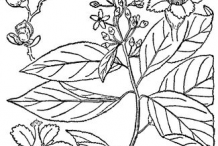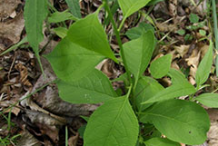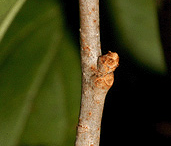The plant belongs to Celastraceae, (The Staff-vine Family). Genus name Celastrus comes from the ancient Greek word kelastros, a name for an evergreen tree. Scandens is Greek for trailing or climbing. The plant is best known for its showy red berries that brighten up fall and winter landscapes. All parts of the plant are potentially toxic. Fruits are poisonous to humans when ingested internally, but are favorites of birds. C. scandens roots were used by Native Americans and pioneers to induce vomiting, to treat venereal disease, and to treat symptoms of tuberculosis.
Plant Description
Bittersweet herb is a rapidly spreading deciduous, twining vine that grows about 15.2 meters (50ft) tall. The herb is found growing in rocky upland woodlands, sandy woodlands, typical savannas and sandy savannas, thickets, partially shaded banks along rivers, woodland edges along roadsides, limestone glades, fence rows, and sand dunes along Lake Michigan. The plant prefers rich, well-drained soils. It is a climbing vine, with an open, spiraling pattern and forms dense thickets along fences. Some stems may become several inches in diameter. Twigs are twiny, light brown, with small pointy buds at nearly right angles to the stems. No tendrils or aerial roots present. Stem are green becoming gray-brown and woody with age. Twining, woody stems are 30 feet (9.1 m) or longer and an inch or more thick at the base. The stems are yellowish-green to brown and wind around other vegetation. Barks are brown, initially smooth, later corky with diamond-shaped patterns, much later becomes finely scaly.
Leaves
Leaves are simple, green, alternate, 2 to 4 inches long and about half as wide, generally oblong-elliptic or sometimes widest above the middle, finely serrated around the edges, hairless, rounded or slightly tapered at the base, often with a long taper to the sharply pointed tip (acuminate), on a hairless stalk about ¾ inch long. Leaves turn yellow in fall.
Flower & Fruit
The flowers are dioecious (individual flowers are either male or female, but only one sex is to be found on any one plant so both male and female plants must be grown if seed is required) and are pollinated by Bees. The plant is not self-fertile. Staminate and pistillate flowers appear in clusters on separate plants in late spring. Flowers are tiny, greenish-white to yellow. Fertilized female flowers give way in summer to spherical orange-yellow fruits. Flowering normally takes place from Jul to August. Fruit is round, about ½ inch in diameter, initially green, the outer casing turning orange to red in late summer, splitting open in fall to disclose the 3-sectioned, bright red, berry-like fruit inside. Fruits are poisonous if ingested, but are considered to be quite tasty by many birds.
Traditional uses and benefits of Bittersweet
- scandens roots were used by Native Americans and pioneers to induce vomiting, to treat venereal disease, and to treat symptoms of tuberculosis.
- Various parts of the plant have been used in decoctions and ointments for a variety of ailments, including cough, intestinal, and gynecological problems.
- Oil is used to increase memory and facilitate learning.
- It induces a feeling of well-being and has reported aphrodisiac effects.
- Root is diaphoretic, diuretic and emetic.
- Root is a folk remedy for chronic liver and skin ailments (including skin cancer), rheumatism, leucorrhoea, dysentery and suppressed menses.
- Strong compound infusion, usually combined with raspberry leaf tea, has been used to reduce the pain of childbirth.
- Poultice of the boiled root has been used to treat obstinate sores, skin eruptions etc.
- Externally, the bark is used as an ointment on burns, scrapes and skin eruptions.
- Extracts of the bark are thought to be cardio active.
- It is highly effective in treating skin infections.
- It is a good herbal remedy for skin troubles like Acne, Wart, ulcers, boils, Eczema, Eruptions, cellulite and wounds.
- It cures eye infections.
- It stops the multiplications of cancer cell, especially suited for Prostate cancer.
- It is a heart tonic thus helps in keeping heart troubles away.
- It is a good herbal remedy for combating respiratory discomforts like Asthma, whooping cough, bronchial catarrh, congestion and bronchitis.
- It counters Scrofula i.e. Tuberculosis due to Lymph Node infection.
- It is beneficial in treating liver ailments and keeping Jaundice at bay.
- It is a rare remedy that counteracts herpes especially Genital herpes.
- It relieves Ulcerative Colitis.
- It helps in treating Obesity.
- It curbs back pain.
- It is favorable in curing joints troubles like joint pain, Arthritis, Rheumatism, swellings and gout.
- It stops the conditions of Diarrhea.
- Decoctions made from bittersweet twigs may also be applied topically onto the skin to ease symptoms and relieve the severity of skin disorders.
- Herb is also traditionally combined with other medicinal herbs such as yellow dock herb root and guaiacum to treat cutaneous diseases including leprosy, tetter, and porrigo.
- It is appreciated for its detoxifying and expectorant properties that help address chronic bronchitis.
- Potent components of bittersweet are touted to fend off disorders associated with cold exposure such as chest pain, dyspnea, and cough.
- Herb is also commonly used as a remedy to both catarrhal headache and nasal catarrh caused by acute colds.
- Herb contains anti-inflammatory properties that soothe symptoms of rheumatism and gout.
- Bittersweet is shown to alleviate ulcers, jaundice, and catarrhal diarrhea.
- Bittersweet stems are commonly taken with wine to address liver and gallbladder disorders.
- Decoction containing bittersweet extracts is shown to address blurred vision.
- Taking decoction may mitigate sore throat during its early stages.
- Herb is found to contain anti-tumor properties that help address cancer of the esophagus.
- It addresses esophageal cancer, leprosy, and other skin diseases.
- Leaf tea is astringent and used for diarrhea and dysentery.
Ayurvedic Health benefits of Bittersweet
- Ulcers: Make a poultice of American Bittersweet boiled root. Apply it thrice on ulcers a day.
- Burns: Make an ointment of American Bittersweet bark. Apply it locally on burns twice a day.
- Labor pain: An infusion of American bittersweet root Powder is mixed with Raspberry leaf tea. Take the mixture to reduce the pain of childbirth.
Culinary Uses
- The Menominee, Ojibwa, and Potawatami tribes of North American Indians have used the inner bark as an emergency food.
- Bark and twigs must be cooked before consuming.
- Thickish bark is sweet and palatable after boiling.
Other Facts
- Branches with colorful berries and arils are used in dry flower arrangements and winter decoration.
- All parts of bittersweet are reported to be poisonous, but songbirds, ruffed grouse, pheasant, and fox squirrel eat the fruits.
Precautions
- Fruits are poisonous to humans when ingested internally, but are favorites of birds.
- All parts of the plant are potentially toxic.
- Overdose may cause paralysis, slow heartbeat, low temperature, vertigo, convulsions.
References:
https://www.itis.gov/servlet/SingleRpt/SingleRpt?search_topic=TSN&search_value=27974#null
https://davesgarden.com/guides/pf/go/1619/
https://npgsweb.ars-grin.gov/gringlobal/taxonomydetail.aspx?id=9727
http://pfaf.org/user/Plant.aspx?LatinName=Celastrus+scandens
http://www.missouribotanicalgarden.org/PlantFinder/PlantFinderDetails.aspx?kempercode=a151
http://www.theplantlist.org/tpl1.1/record/kew-2707703
https://plants.usda.gov/core/profile?symbol=CESC
http://medicinalherbinfo.org/herbs/Bittersweet.html#top
http://www.bio.brandeis.edu/fieldbio/medicinal_plants/pages/American_Bittersweet.htm
https://en.wikipedia.org/wiki/Celastrus_scandens
http://dendro.cnre.vt.edu/dendrology/syllabus/factsheet.cfm?ID=913
https://plants.usda.gov/factsheet/pdf/fs_cesc.pdf
https://plants.ces.ncsu.edu/plants/all/celastrus-scandens/
https://www.entm.purdue.edu/iisc/pdf/plants/more/oriental_bittersweet.pdf
Comments
| Bittersweet Quick Facts | |
|---|---|
| Name: | Bittersweet |
| Scientific Name: | Celastrus scandens |
| Origin | Central and eastern North America |
| Colors | Green, turning orange to red |
| Shapes | Round, about ½ inch in diameter |
| Taste | Bitter sweet |
| Health benefits | Good for chronic liver and skin ailments, rheumatism, leucorrhoea, dysentery and suppressed menses |
| Name | Bittersweet |
|---|---|
| Scientific Name | Celastrus scandens |
| Native | Central and eastern North America |
| Common Names | American bittersweet, bittersweet, bitter nightshade, woody nightshade, climbing bittersweet, false bittersweet, climbing orange-root, fever-twig, fever-twitch, staff-vine, jacob’s-ladder, waxwork |
| Name in Other Languages | English: American bittersweet, Climbing Bittersweet, staffvine, waxwork, Shrubby bittersweet Finnish: Amerikankelasköynnös French: Bourreau-des-arbres, Célastre grimpant Swedish: Amerikansk traddodare |
| Plant Growth Habit | Rapidly spreading deciduous, twining vine |
| Growing Climate | Rocky upland woodlands, sandy woodlands, typical savannas and sandy savannas, thickets, partially shaded banks along rivers |
| Soil | Rich, well-drained soils |
| Plant Size | 15.2 meters (50ft) |
| Forms | Climbing vine, with an open, spiraling pattern. Forms dense thickets along fences. Some stems may become several inches in diameter |
| Twigs | Twiny, light brown, with small pointy buds at nearly right angles to the stems. No tendrils or aerial roots present. |
| Bark | Brown, initially smooth, later corky with diamond-shaped patterns, much later becomes finely scaly |
| Stem | Twining, woody stems are 30 feet (9.1 m) or longer and an inch or more thick at the base. |
| Branch | Branches are round, glabrous, light to dark brown, usually with noticeable lenticels |
| Leaf | Simple, green, alternate, 2 to 4 inches long and about half as wide, generally oblong-elliptic or sometimes widest above the middle, finely serrated around the edges, hairless |
| Flowering Periods | Jul to August |
| Flower | Tiny, clustered and green scentless flowers at the tips of the branches |
| Fruit Shape & Size | Fruit is round, about ½ inch in diameter, initially green, the outer casing turning orange to red in late summer |
| Fruit Color | Initially green, turning orange to red |
| Taste | Bitter sweet |
| Plant Parts Used | Twigs, leaves, root, bark. Best Preparation is from fresh green stems and leaves, gathered before flowering. |
| Poisonous Part | All parts mostly seeds |
| Season | October |


